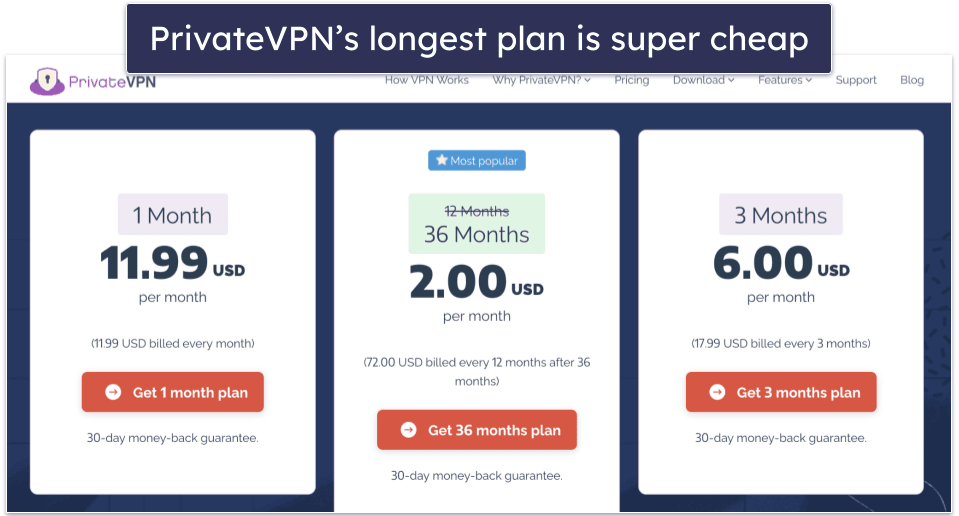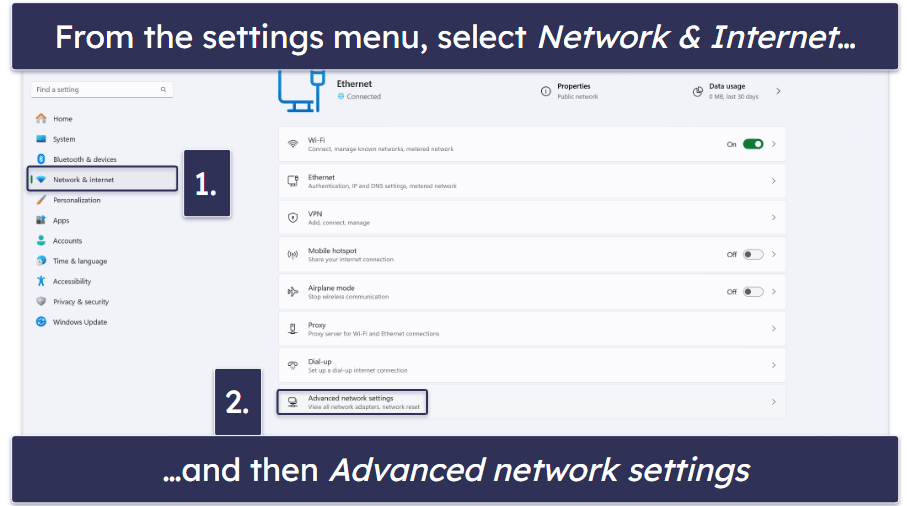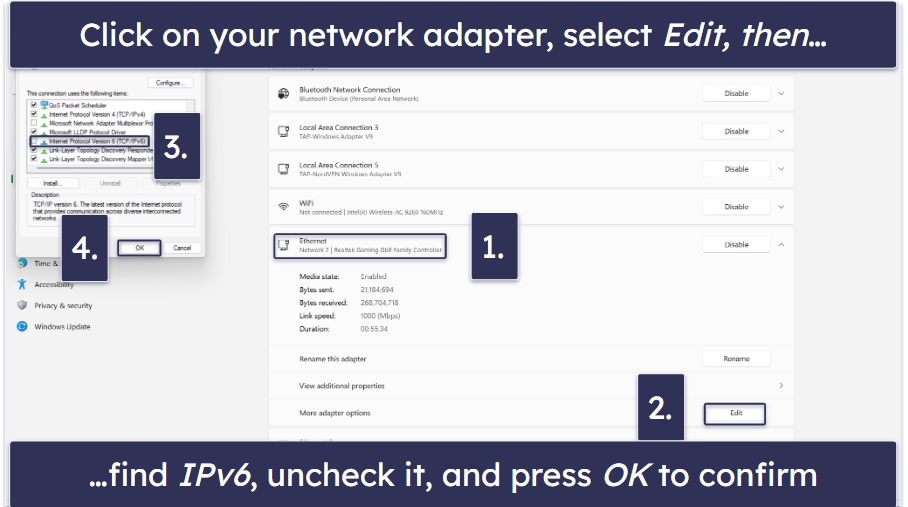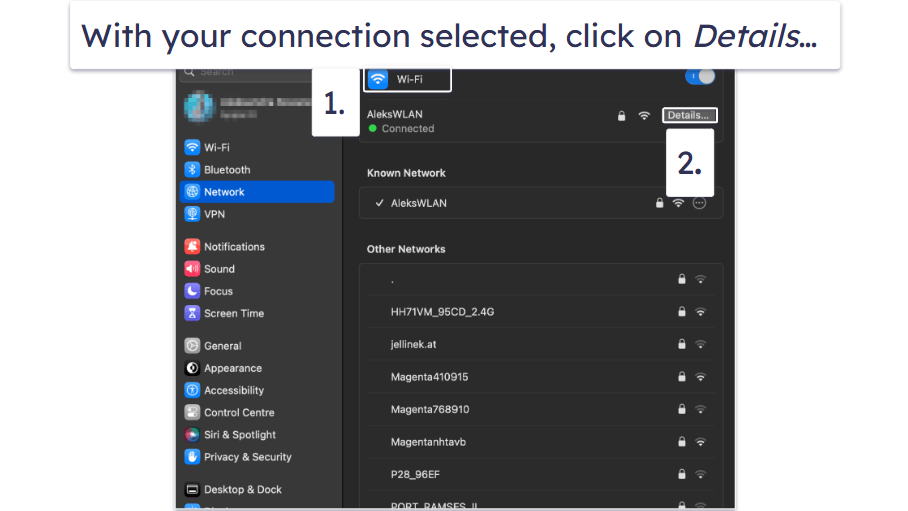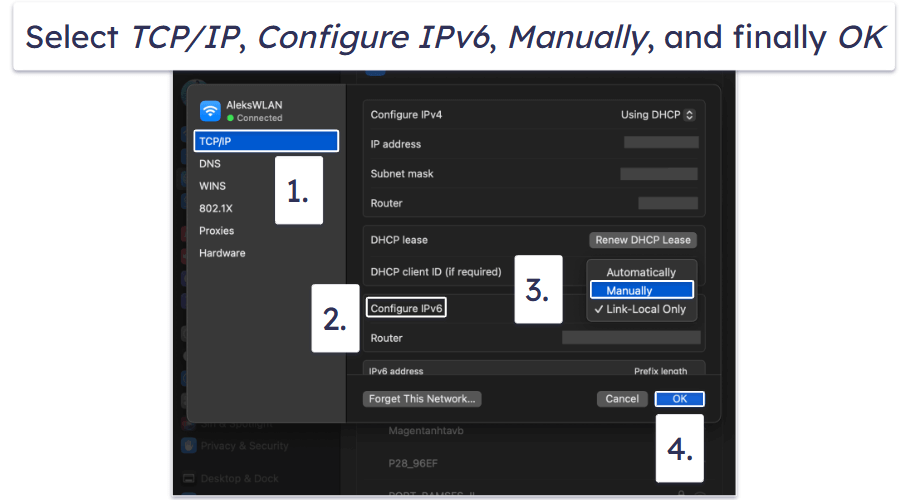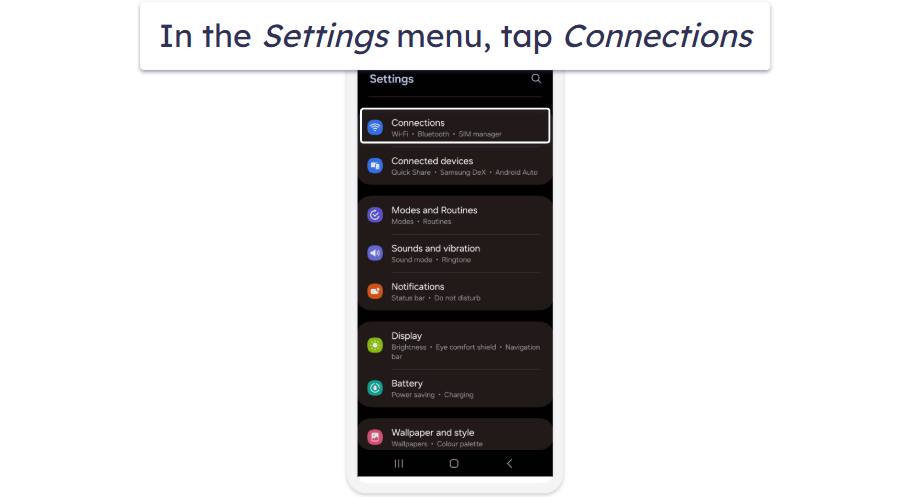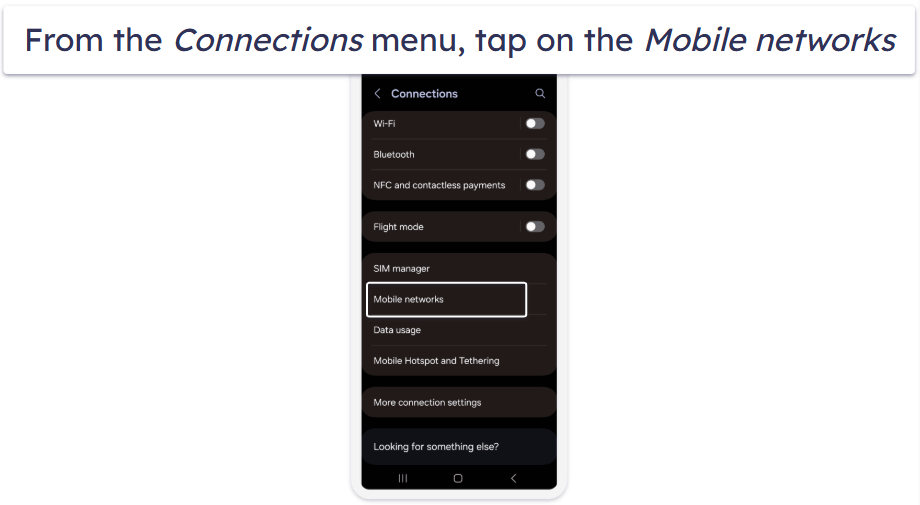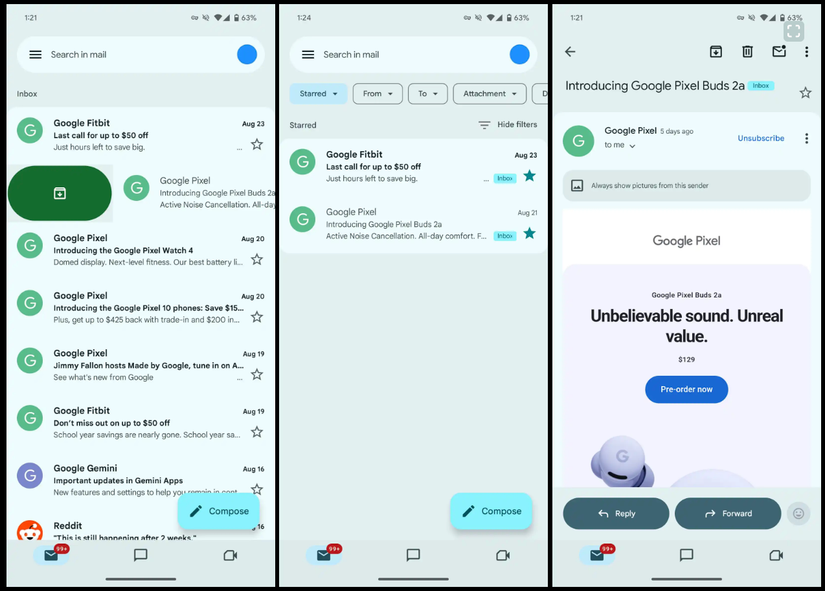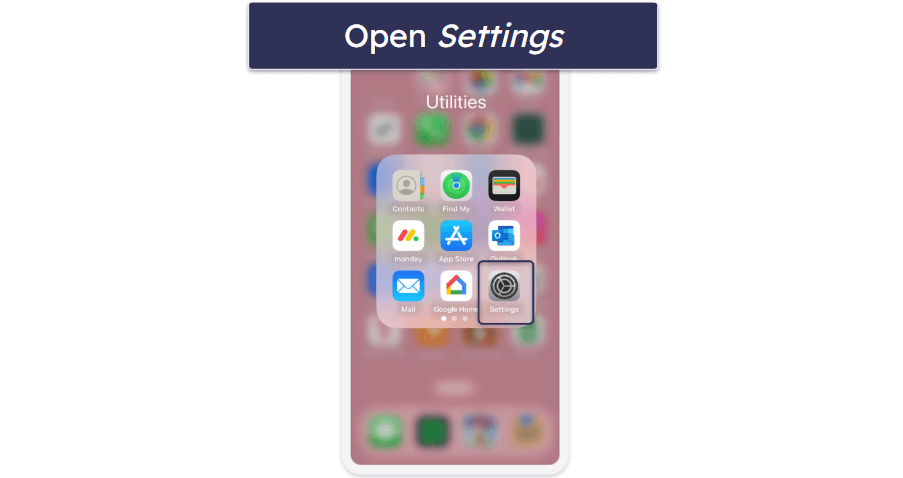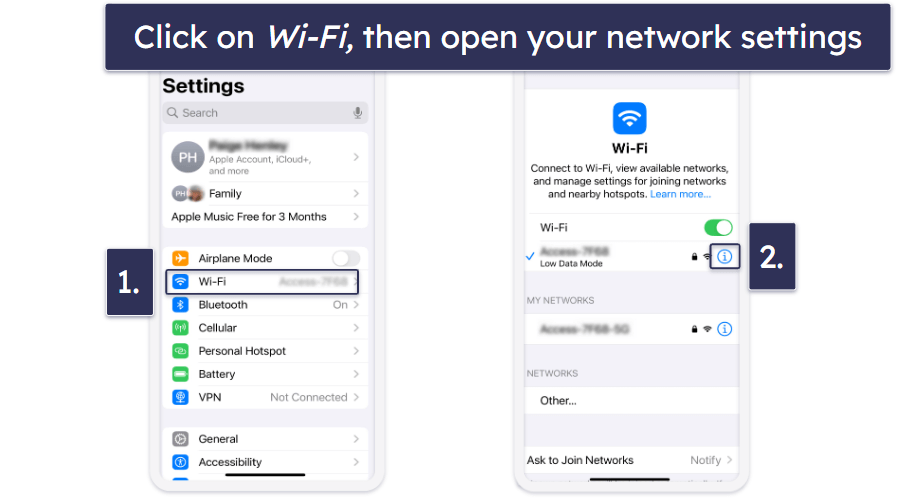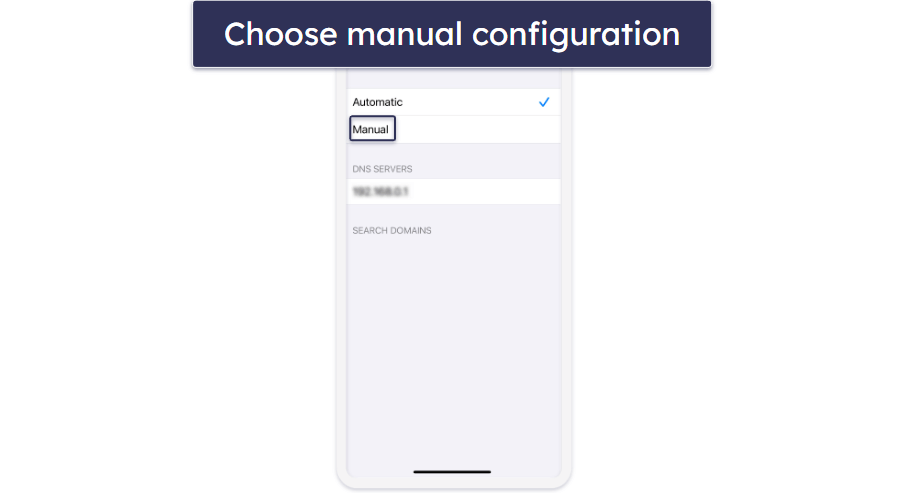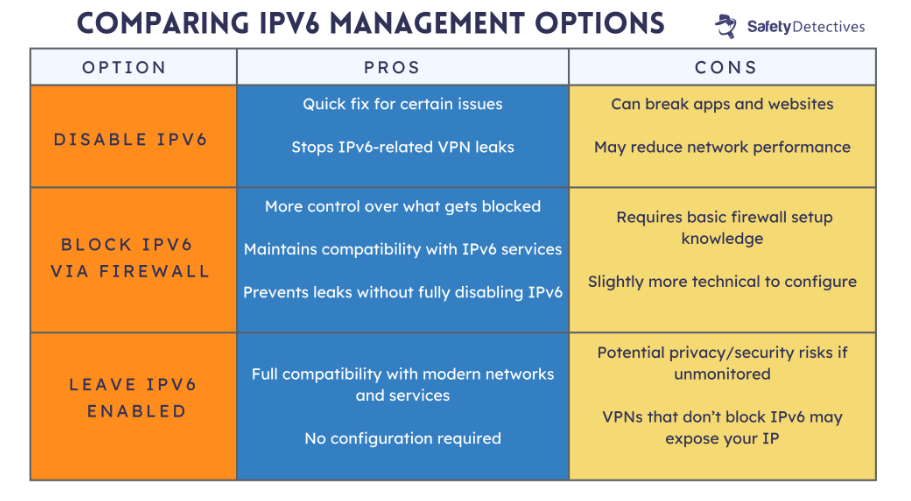Paige Henley
Published on: July 8, 2025
Fact-checked by Sam Boyd
Disabling IPv6 can be useful in certain situations, such as when you’re troubleshooting network issues, improving compatibility with older systems, or configuring a VPN that doesn’t support IPv6 traffic. While IPv6 is designed to replace the older IPv4 protocol and is a more advanced version, not every network or application is fully ready for it. In some cases, having it enabled can cause more problems than it solves.
This guide will walk you through how to disable IPv6 on major operating systems, including Windows 11, macOS, Linux, Android, and iOS. We’ll also cover why you might want to disable it and the potential downsides.
How to Disable IPv6 on Windows 11
First, let’s look at how to disable IPV6 on Windows 11 computers. Here’s a step-by-step guide on how to do it through the network settings menu.
- Click on the Windows button on your taskbar, then search for and click on the Settings app.
- From the Settings menu, select Network & Internet and then click on Advanced network settings.
- Find and click on your network adapter, and click on Edit to open advanced settings.
- From here, find Internet Protocol Version 6 (TCP/IPv6) and uncheck it, then press OK.
- Voila! You’ve disabled IPv6 on your connection. You can repeat the process for any other internet connections, such as your Wi-Fi.
How to Disable IPv6 on macOS
Here’s how to do the same procedure of disabling IPv6 on your macOS devices:
- Open the Apple menu and go to System Preferences, then click on Network.
- Select your active network connection (like Wi-Fi or Ethernet), then click the Details button in the lower right corner.
- Head over to the TCP/IP tab. Under Configure IPv6, choose Manually from the dropdown menu and click OK to confirm.
- And that’s it — IPv6 is now disabled for that connection. You can repeat the steps for other network interfaces if needed, or re-enable it by choosing On in the third step.
How to Disable IPv6 on Linux
There are multiple ways to disable IPv6 on a Linux system, but the simplest option is to update your system’s configuration file to tell it to turn off IPv6 across all network interfaces. Here’s how to do it:
- Start by launching the Terminal from your applications menu. This is where you’ll make the necessary changes.
- Open the system configuration file (sysctl.conf), which controls various network and kernel parameters.
- Scroll to the bottom of the file and add the following lines to it:
net.ipv6.conf.all.disable_ipv6 = 1
net.ipv6.conf.default.disable_ipv6 = 1
net.ipv6.conf.lo.disable_ipv6 = 1
net.ipv6.conf.tun0.disable_ipv6 = 1 (only needed if you’re using a VPN that uses a tun0 interface)
- Save the file by pressing CTRL+O, then Enter, and then CTRL+X to exit.
- Apply the changes by typing in sudo sysctl -p
- (Optional) Restart your device. This likely won’t be necessary, but it will ensure that all network interfaces reflect the updated configuration.
How to Disable IPv6 on Android
Disabling IPv6 on Android is pretty straightforward. Here’s how you do it:
- Open your phone’s Settings menu and tap on Connections.
- Once in the Connections menu, tap Mobile networks.
- From the Mobile networks menu, select Access Point Names.
- Locate your connection from the list and tap it.
- Click on APN Protocol in the following menu, and select IPv4 to ensure IPv6 is turned off. If you want to turn it on, just select it from this menu.
How to Disable IPv6 on iOS
iOS does not provide any native option to disable IPv6 manually. Apple’s networking stack prioritizes IPv6 when available, and users cannot disable the protocol entirely through system settings.
However, there is a partial workaround: by editing the DNS settings, you can prevent your device from using IPv6 DNS servers. This doesn’t fully disable IPv6 traffic, but it may reduce or redirect how certain requests are handled. Here’s how you can do that:
- Tap on Settings.
- Select Wi-Fi, then tap the (i) icon next to your connected network.
- Tap Configure DNS.
- Select Manual.
- Remove any listed IPv6 DNS addresses (these start with 2001:, 2606:, etc.).
- Tap Save.
Note that this change only affects DNS resolution and does not stop the device from using IPv6 for other types of traffic, so it’s not a complete disable. The only true way to block IPv6 on iOS is to use a router or VPN configuration that filters or blocks IPv6 at the network level.
How to Disable IPv6 on a Router
With most routers, you should be able to disable the IPv6 protocol from their web interface. Here’s how:
- Open a web browser and type your router’s IP address into the address bar.
- Sign in using your router’s username and password.
- Navigate to the section that contains IPv6 settings, often found under Advanced or Network.
- Turn off IPv6 and then click on Save, Apply, or Apply Settings depending on your router model.
What Is IPv6 and Why Would You Want to Disable It?
IPv6, or Internet Protocol version 6, is the modern standard for identifying and communicating between devices on a network. While it’s meant to replace IPv4 and bring several improvements, there are still situations where turning it off is the more practical choice.
IPv6 expands the number of available IP addresses and includes features like improved routing and built-in security. However, not all networks or applications are fully compatible with it, which can lead to technical issues that necessitate turning it off.
Common Reasons to Disable IPv6
Although IPv6 is the future of networking, there are valid reasons you might want to disable it, especially if you’re dealing with compatibility, performance, or security concerns. Below are some of the most common situations where disabling IPv6 can be helpful.
VPN Compatibility and Privacy
Although the best ones do, some VPNs don’t fully support or block IPv6 traffic, which can cause your real IP address to leak even when connected to a VPN. Disabling IPv6 helps ensure all traffic is routed securely through the VPN tunnel.
Network Troubleshooting
If you’re experiencing inconsistent access to websites or services, like pages loading slowly or not at all, IPv6 could be part of the problem. Some ISPs or routers don’t handle IPv4 and IPv6 traffic equally well, and disabling IPv6 can simplify the connection and help isolate issues.
Improving Security
While IPv6 was designed with modern security in mind, it introduces new protocols and behaviors that not all firewalls or monitoring tools are configured to handle. In environments where IPv6 isn’t actively used or monitored, it can create unexpected vulnerabilities. Disabling it reduces the attack surface, especially on networks relying solely on IPv4.
Application or Device Incompatibility
Older applications, smart devices, or network hardware may not fully support IPv6, leading to connection errors or performance issues. Disabling IPv6 allows these systems to fall back on the more universally compatible IPv4.
Should You Disable IPv6? Risks and Safer Alternatives
Disabling IPv6 can solve specific problems, but it’s not always a reliable long-term solution. As more networks and services default to IPv6, turning it off may cause more issues than it resolves.
What Can Go Wrong If You Disable IPv6?
Some modern websites and apps prefer or require IPv6 to function properly. Disabling it can lead to slower connections, missing features, or failure to load entirely. You may also run into problems with network discovery, cloud services, or internal tools that rely on IPv6 connectivity.
A Safer Alternative: Block or Limit IPv6 with a Firewall
Instead of turning off IPv6 completely, use your firewall to block or limit unwanted IPv6 traffic. This gives you more control while keeping the protocol enabled for apps and services that rely on it. You’ll avoid compatibility issues, reduce the risk of IPv6 leaks with VPNs, and maintain broader support for future-proof networking.
Frequently Asked Questions
Do I need to disable IPv6 to use a VPN?
You likely won’t need to. Most good modern VPNs support both IPv4 and IPv6. However, if your VPN doesn’t handle IPv6 traffic properly, it can cause IPv6 leaks, which will expose your real IP to the world. In that case, disabling IPv6 can be a workaround to ensure your VPN is fully protecting the privacy of your traffic.
Is it safe to disable IPv6 on my computer?
Yes, it is generally safe to disable IPv6 for most home and office users. Many networks and services still use IPv4, and vital internet activity won’t be affected. However, some newer services or enterprise environments might rely on IPv6, so it’s good to test your setup’s performance after disabling it.
What problems can happen if I disable IPv6?
Disabling IPv6 might cause connectivity issues on IPv6-only websites. It can also cause delays in DNS resolution if your system is expecting an IPv6 response before falling back to IPv4 (though this is typically not a problem if you’re using a modern operating system). Finally, some specific Microsoft services or features like DirectAccess depend on IPv6, but this is only going to be a problem on corporate networks.
Can I re-enable IPv6 after disabling it?
Yes, of course. The simplest way is to just follow the steps we’ve outlined above for disabling it, and then check the box which you previously unchecked to re-enable it. For example, for Windows 11, you’d go to Settings > Network & Internet > Advanced network settings, choose your internet connection, click on Edit, and make sure you check the box next to Internet Protocol Version 6 (TCP/IPv6), and click OK.
Does disabling IPv6 help with online privacy?
Potentially, yes — but it depends on other factors. If your VPN doesn’t support or block IPv6, then IPv6 traffic may leak outside the VPN tunnel, exposing your private details, such as your IP address, to the world. Disabling IPv6 can help reduce the risk of IP leaks, making your VPN more effective. However, on its own, disabling IPv6 won’t make any meaningful changes to your privacy settings unless it’s part of a broader privacy setup.


